The device, varieties and installation rules of coaxial chimneys
An autonomous heating system, if it does not work on electricity, cannot do without a device that takes off the products of combustion. If earlier it could only be a traditional chimney, now other options have appeared, more effective and practical.
Installation of a coaxial chimney gives many advantages, in addition, it can be produced in an already built building. What is so good coaxial type chimney? We'll figure out.
The content of the article:
Coaxial chimney: what is it?
In technology, the concept of “coaxial” means the presence of two any objects arranged so that one is inside the other. Thus, the coaxial type chimney is a double-circuit design made of pipes of different diameters.
Inside the larger element is a smaller part. The distance between them is strictly the same over the entire length of the structure, including all bends and knees.
For this, special jumpers are located between the pipes. In a section, such a system looks like a pair of concentric rings. The smoke removal channel is an inner, smaller pipe.
Through the gap between the two parts, the oxygen necessary for maintaining combustion enters the heater from the street. Thus, the gases inside the system move in opposite directions.
The design features of the coaxial type chimney enable it to perform functions immediately. The device provides uninterrupted air flow, which is necessary to maintain the combustion process.
In addition, it successfully removes combustion products from the boiler. The length of the structure usually does not exceed two meters. Most often mounted systems oriented horizontally, but there are also vertical variations.
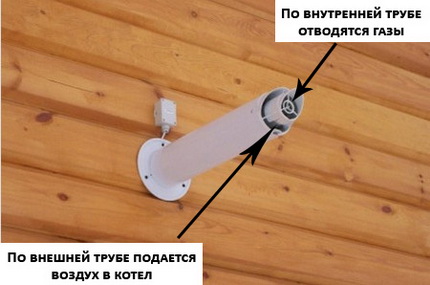
The coaxial type chimney is a system of modules, which makes it possible to produce chimneys of various configurations taking into account the architectural features of the building. All elements included in the system are standardized, which greatly simplifies their installation.
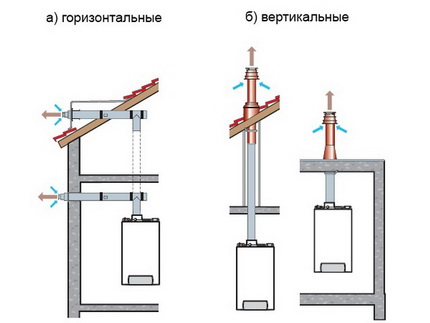
The standard kit consists of several modules:
- Straight pipes. From straight pipe segments a chimney proper is formed.
- Tee. It is mounted in the system only if two or more boilers are used.
- Connecting elements. These are 90 ° and 45 ° bends, couplings.
- Condensate discharge device. Such a kit is necessarily provided for each vertically oriented area. It is equipped with a water lock, which prevents a decrease in the pressure of the gas-air mixture in the chimney.
- Elements with a revision hole. They are designed to inspect and clean the system.
- Output and input nozzles. Delivered complete with heads, used to remove combustion products and clean air intake. The outlet nozzle is always mounted at a distance from the air intake so that it does not mix with the exhaust gases.
- Adapter. It is used to connect the system to the boiler.
- Fittings for fasteners. These include brackets, clamps and flanges.
- Seals. Devices required to ensure the tightness of the passage of the pipe through the wall or roof.
- Decorative overlays. Flanges covering the passage of the chimney barrel through building structures.
For the manufacture of parts for coaxial chimneys, galvanized or stainless steel is used. It is resistant to high temperatures, durable and light.
Some models are made of aluminum alloys or heat-resistant plastic.Seals are used for joints made of heat-resistant polymers capable of withstanding temperatures of the order of 230-250 °.
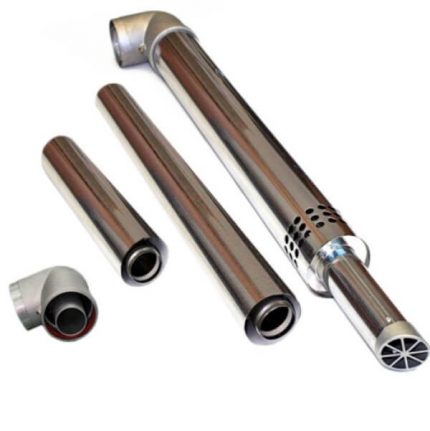
Varieties of coaxial chimneys
There are several types of pipe-in-pipe construction. We will consider each of them in detail.
External and internal systems
All coaxial chimneys, depending on their location, are divided into external and internal. The first are located on the outside of the building and are fixed directly on the facade.
Given that such structures somewhat spoil the appearance of the building, they try to place them on the inner sides of the building. A distinctive feature of the outdoor chimney is its ease of maintenance and installation.
Internal structures are mounted in specially laid mines, which pass inside the building and are separated from residential premises. In some cases, traditional chimneys can be used as such shafts.
It is important that their design and dimensions fully comply with current fire safety requirements. Internal systems are quite difficult to maintain and install.
Not warmed and warmed devices
In cold weather, especially in severe frosts, the channel supplying air to the system can freeze. In this case, the amount of oxygen entering the combustion chamber decreases sharply, which leads to a deterioration in the operation of the heating device.
In some cases, and to his stop. Therefore, where low temperatures last for a rather long period of time, and also where severe frosts are frequent in winter, it is recommended to install insulated systems.
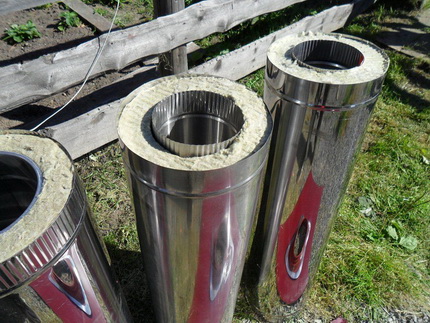
The coaxial chimney of the insulated type differs from the standard one by the presence of one more pipe. The system looks like three parts embedded in each other.
The free space between the two extreme elements is insulated. For this purpose, it is filled with any suitable insulation. This reliably protects the air channel from icing and freezing.
Horizontal or vertical output
Initially, coaxial chimneys were designed as horizontally oriented systems, but in practice this arrangement is not always possible. Most chimneys of this type are mixed structures.
They may contain both vertically oriented and horizontal sections. This is due to the location of the heater in the building. In some cases, it is possible to use vertical chimneys, but only for boilers without forced draft.
Collective and individual designs
To service one heater, individual coaxial flues are used. These are simple branchless systems that can have various configurations.
To work with several boilers, a collective chimney is mounted. This is a multi-branch shaft system. In this case, each of the branches goes to one of the heat generators. This design can only be vertical.
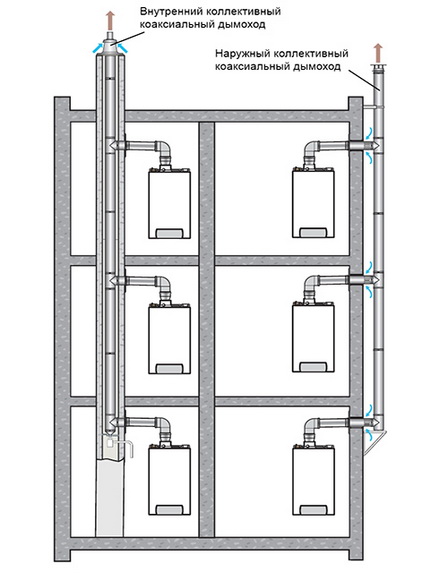
Why choose coaxial systems?
The design features of the coaxial type chimney enable it to work on a principle different from the traditional chimney. To ensure combustion, oxygen must be supplied to the boiler furnace, and combustion products must be removed.
Boilers equipped with separate chimneys take air from the room in which they are installed.This is quite dangerous for humans and requires constant ventilation of the room.
Exhaust fumes are vented out through natural draft. Devices with coaxial flues work differently. Such chimneys are a combined system of air supply and smoke exhaust.
The draft required for the operation of the device is created naturally or with the help of a fan, which allows the use of small-length structures.
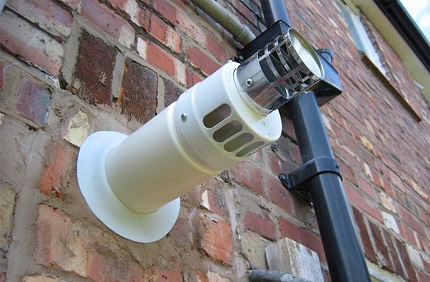
Thus, the complete isolation of the removal of combustion products and oxygen supply makes it possible to completely eliminate their effect on the composition of the air in the room where the boiler is installed.
"Burning" of oxygen does not occur, as a result of which the room is not required to be ventilated. The amount of air in the combustion chamber is optimal, which increases the percentage of fuel combustion and, as a result, the boiler works more efficiently and environmentally.
Hot smoke from the heater is discharged through the inner pipe. It passes inside another, through which cold air moves. Thus, there is no thermal effect on the walls and floors, inside which a chimney is laid.
This significantly increases its fire safety, which is very important for buildings made of wood and other fairly flammable materials.
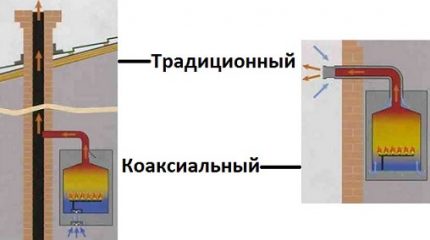
The coaxial system increases the efficiency of the heater. This is due to the fact that the air supplied to the furnace, passing through the internal cavity of the structure, is heated from the pipe that removes hot smoke.
Another significant advantage of this type of chimneys is its compactness and relatively small size, especially compared to traditional chimneys.
It would be a mistake to think that the system has no shortcomings. They are. First of all, this is a rather high cost of such a design. On average, it is 40% more expensive than traditional. Another is due to the coaxial type chimney device.
Pipes come in contact with hot smoke and cold air, which inevitably leads to the formation of condensate, especially in cold weather. Thus, the system needs a special drain for condensate and additional warming, which further increases its cost.
Features of choosing the size of the device
In the technical documentation that is attached to the chimney, its diameter must be indicated. The designation is two digits written in fractions.
The first of them shows the diameter of the inner pipe, the second - the outer. Choosing the right size is quite simple. It must be indicated in the passport of the boiler, which will be connected to such a chimney.
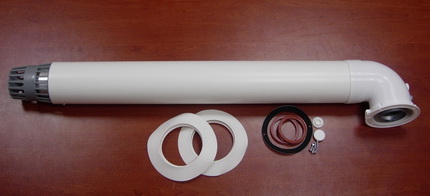
The determining indicator in this case will be not only the diameter of the system, but also its length. The latter is defined as the sum of the lengths of all sections of the chimney.
It has the limitations set forth in the installation instructions and is measured in equivalent meters. In addition, all these nuances are indicated in the selection table, which should be attached to the technical documentation of the heating equipment.
Chimney installation in the light of regulations
The coaxial smoke exhaust system can be installed in a private or multi-apartment building. The latter is also quite common, especially in connection with the widespread installation of individual heating systems in apartments.
Until 2012, the design and installation of coaxial chimneys in apartment buildings and private houses were regulated by one SNiP and did not differ.
In 2012, a set of rules was adopted SP 60.13330.2012, which is an updated edition SNiP 41-01-2003. The document shared the installation conditions for a coaxial chimney in an individual and an apartment building. In the latter case, it is forbidden to install individual chimneys in apartments, as was previously permitted, and the installation of a collective chimney is prescribed.
Therefore, you need to be very careful and know that if the designers propose to equip an individual exhaust gas from a heat generator located in one of the apartments of an apartment building, this contradicts the current standards.
The distance from the ridge of the roof of the building to the cross section of the chimney must be at least 1.5 m. A similar value for a private house is from 0.5 m.
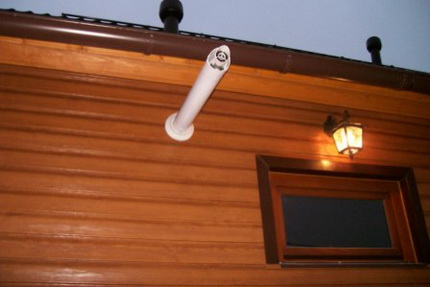
No special acts regarding individual buildings have been adopted, therefore it is believed that their arrangement should not contradict the requirements applicable when installing chimneys in apartment buildings. Based on the new edition of SNiP, in private houses coaxial systems of any type can be installed. In multi-apartment buildings - only vertical ones.
An important nuance. If chimneys were installed in the building before 2012 that contradict the current version, they can be left unchanged if they do not cause inconvenience to neighbors.
Some installation features
For each boiler, the direction of the channel leading off the combustion products is determined individually. Horizontal systems can only be used with forced ventilation devices.
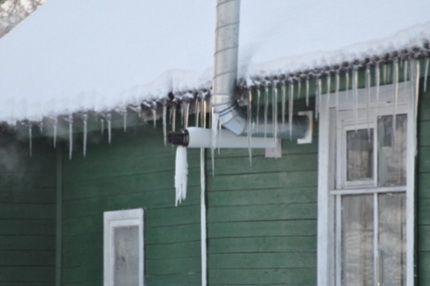
But in this case, the maximum length of such a section should not be more than 3 m. It happens that the manufacturer sets other standards for his boilers, so you should familiarize yourself with the technical documentation of the device.
Vertical type constructions for private houses are used only if there are reasons preventing the exit of the chimney duct through the wall.
It can be windows close to the exit pipe, a narrow street on which the building stands, and the like. In some cases, if it is very necessary, inclined installation of a coaxial chimney pipe is allowed.

The system is connected to the heater using a tee, elbow or pipe. In this case, the diameters of the outlet channel and the boiler outlet must be the same.
During installation, all subsequent parts are fixed in the preceding ones so that there are no obstacles that can disrupt the movement of combustion products. The number and type of elements for assembly directly depends on the location of the outlet pipe.
If it is located on the side, the arrangement of a horizontal system is assumed, if on top - a vertical one. The latter option is easier to install.
In the process of arranging a coaxial chimney, transitional units with rigid fastening of the joints of the two elements with clamps are necessarily used. Some "craftsmen" prefer to use homemade options.
These can be adapters made by hand, tape winders or sealant seals. Such things are unacceptable to use, because they are extremely unreliable. A system assembled using such elements is considered unsafe to operate.
In addition, the following rules are observed during installation:
- The outgoing section of the horizontal chimney should be tilted 3 ° down. At the horizontal section entering the common chimney section, the slope is performed in the opposite direction, that is, it decreases towards the boiler. This is necessary for unimpeded drainage of condensate.
- Throughout the chimney, there should be no more than two folds.
- Inspection hatches, adapters, and condensate drainage equipment should be easily accessible for periodic inspection.
- The chimney cannot be removed below ground level. At the same time, the distance from the outlet of the coaxial chimney to the neighboring building should be more than 8 m. If a deflector is installed on the pipe, this distance is reduced to 2 m for a blank wall and 5 m for a wall with window openings.
- If the horizontal chimney is installed in a place where winds prevail, the direction of which is opposite to the direction of the smoke, it is necessary to install a screen from the sheet at the pipe outlet. The distance between it and the outlet must be at least 0.4 m.
- On coaxial chimneys towering less than 1.8 m above the ground, a baffle must be installed. It will work as protection against hot smoke.
All structural elements must fit snugly together. Each subsequent part must enter the previous one at a distance equal to at least half the diameter of the channel section.
To circle the structure around any obstacle, specially designed for this knee are used. The angle of their inclination may be different. If the system is discharged through the roof, all fire safety requirements must be observed.
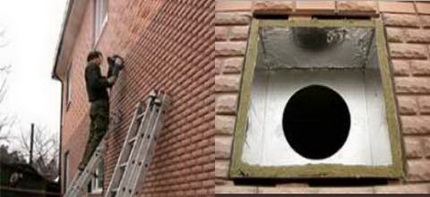
For this purpose, special insulating pipes and non-combustible insulating materials are used. There must be an air gap between the pipe and the ceiling.
In order to avoid contact of the flue channel and fragments of the roofing cake, a protective cover is used. The structure exit through the roof is carefully sealed. The joints are covered with a special apron.
Coaxial Chimney Mounting Technology
The installation process of the external and internal coaxial chimney is different. Consider both options.
Installation of the internal system
First of all, we check the compliance of the diameters of the outlet pipe of the boiler and the chimney. Then we begin to prepare a hole in the wall through which the chimney will go out.
Its diameter must exactly match the dimensions of the coaxial pipe. After making the hole, you can proceed with the installation of the structure. It begins with the outlet pipe of the boiler, to which the corresponding element of the chimney is attached.
The resulting connection is fixed with a clamp and fixed on both sides with bolts. Next, the entire structure is sequentially assembled. Each element is inserted into place and secured with special clamps to give the system additional reliability. Decorative fasteners are installed on top of the mounts, so the attractive appearance of the structure is preserved.
The chimney is discharged through the wall into the street. If necessary, install on the outlet pipe deflector or additional wind protection. The section of the passage in the wall is closed up. At the same time, fire safety requirements are observed. A special protective cover is put on the pipe. The joints of the passage are sealed and covered with an apron.
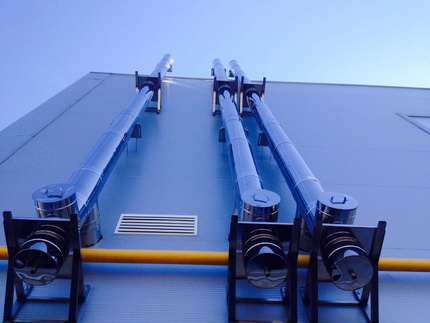
Outdoor installation
Before it begins, determine the exit location of the coaxial chimney and outline its location on the wall of the building. Then a hole is made in the wall with a diameter corresponding to the cross section of the flue channel.
Next, all internal work is carried out. Start by connecting the pipe to the heater. For this, a single-circuit elbow and a double-circuit tee are used.
The latter is needed to secure the structure in an upright position. The resulting structure is fixed to the wall surface with special brackets.
Further, all work is carried out similarly to the method described above. The chimney exit section is closed and pipe assembly continues to the desired height. The design is fixed to the wall with clamps. To connect double-circuit pipes, transition nodes are used.
Conclusions and useful video on the topic
The device and installation of the coaxial chimney:
Installation of a coaxial type chimney in a wooden house:
How to install a coaxial chimney yourself:
The coaxial type chimney is an efficient and practical device that significantly increases the efficiency of the heater. In addition, it is absolutely safe to operate, compact and easy to install.
Its only significant drawback can be considered a fairly high cost of arranging such a system, which, however, pays off for its long effective work.
Please leave your comments on the article, share your experience of using and the features of the installation of coaxial flues known to you, ask questions. We are always ready to clarify incomprehensible points.

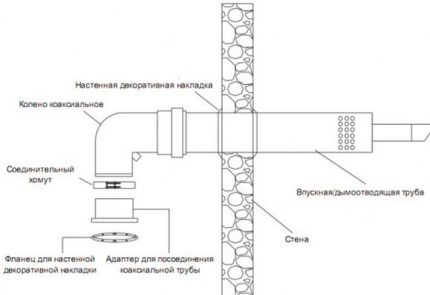
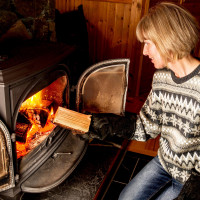 Chimney sweep log for chimney cleaning: composition of the product and rules of use + owner reviews
Chimney sweep log for chimney cleaning: composition of the product and rules of use + owner reviews 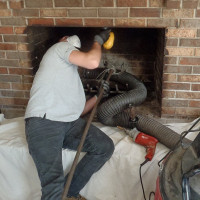 Cleaning chimneys of stoves and fireplaces from soot: the best means and methods of getting rid of soot in a pipe
Cleaning chimneys of stoves and fireplaces from soot: the best means and methods of getting rid of soot in a pipe  Which pipe to choose for the chimney: regulatory guidelines and rules
Which pipe to choose for the chimney: regulatory guidelines and rules  How to assemble and install a do-it-yourself sandwich chimney: installation instructions
How to assemble and install a do-it-yourself sandwich chimney: installation instructions  The furnace for working out of the pipe: how to make an effective furnace for used oil from improvised materials
The furnace for working out of the pipe: how to make an effective furnace for used oil from improvised materials 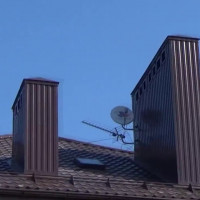 Insulation for a gas chimney: options for thermal insulation and technology of insulation of chimneys
Insulation for a gas chimney: options for thermal insulation and technology of insulation of chimneys  How much does it cost to connect gas to a private house: the price of organizing gas supply
How much does it cost to connect gas to a private house: the price of organizing gas supply  The best washing machines with dryer: model rating and customer tips
The best washing machines with dryer: model rating and customer tips  What is the color temperature of light and the nuances of choosing the temperature of the lamps to suit your needs
What is the color temperature of light and the nuances of choosing the temperature of the lamps to suit your needs  Replacement of a geyser in an apartment: replacement paperwork + basic norms and requirements
Replacement of a geyser in an apartment: replacement paperwork + basic norms and requirements
The question is simple, but still requires an answer from professionals.
Parents of a friend built a house of timber, builders installed a similar pipe with insulation. Everything is fine, they stopped by to live in the house, winter came and, naturally, on especially frosty days the stove was heated a little more. By the way, the pipe was strictly vertical. As a result, the inter-wall insulation in the pipe melted, flowed down and a fire occurred.
Thank God everyone remained alive and well, but the damage was enormous, firefighters flooded the whole house, all appliances and furniture became unusable, as well as wiring with interior decoration, saved only the walls and lives of residents.
Question - why did their insulation melt, maybe the builders did something wrong for them? How dangerous are such designs?
In this case, there is the unfair work of specialists who were involved in the installation of the chimney. Do you have a fire inspection report on the cause of the fire? Usually they issue such papers after an examination. You can try to resolve this issue with representatives of the company who were engaged in the installation, in the pretrial order. If you fail to agree on compensation, you will have to go to court.
The most important question is what is indicated as a cause of fire in the fire inspection report?
I’ll supplement Alexey’s question.Besides the conclusion from the fire service, was there a formal contract with the builders? But in this whole story, the combination of a stove and a coaxial chimney guarded me much more ... What kind of stove is it? Is it a solid fuel or gas furnace nozzle?
To be honest, I'm confused. For the first time, I just hear about coax on the stove ...
Strange, some kind of unreal situation. The melting temperature of mineral wool is 1500 - 1700º, the temperature of flue gases during the combustion of solid fuel is 500 - 700º (this is the limit). The insulation could not be melted corny in such an environment.
Most likely, they did not have a coaxial chimney, but an analogue of a sandwich type. When assembling it, it is imperative to observe the direction of the connection of the modules so that the condensate does not drain down the inner surface and does not corrode the walls. That corrosion of the chimney due to condensate aggression could well have caused the subsequent fire. If so, then the builders are really to blame.